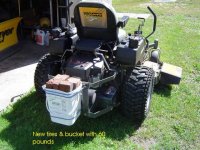cttractor
Silver Member
Well, think about it. Regardless of the approach, we can never have weight any lower than the wheels themselves. The lowest weighting we can apply to a tractor is filled tires, followed by wheel weights in the middle of the wheel. If the weight is low enough and the mower is wide enough, it should be able to handle some rather steep inclines.
I don't know what weights you've mounted from side-to-side on the mower already, or what they look like -- perhaps you could provide a photo or simple sketch. What if you were to do nothing more than increase the weight you've already mounted at that low location? Did you notice any improvement in stability from the weights you've already added? If so, more weight might be all you need to add, as long as the frame can take it. It certainly has the advantage of being simple and requiring absolutely no control system whatsoever.
I don't know what weights you've mounted from side-to-side on the mower already, or what they look like -- perhaps you could provide a photo or simple sketch. What if you were to do nothing more than increase the weight you've already mounted at that low location? Did you notice any improvement in stability from the weights you've already added? If so, more weight might be all you need to add, as long as the frame can take it. It certainly has the advantage of being simple and requiring absolutely no control system whatsoever.
